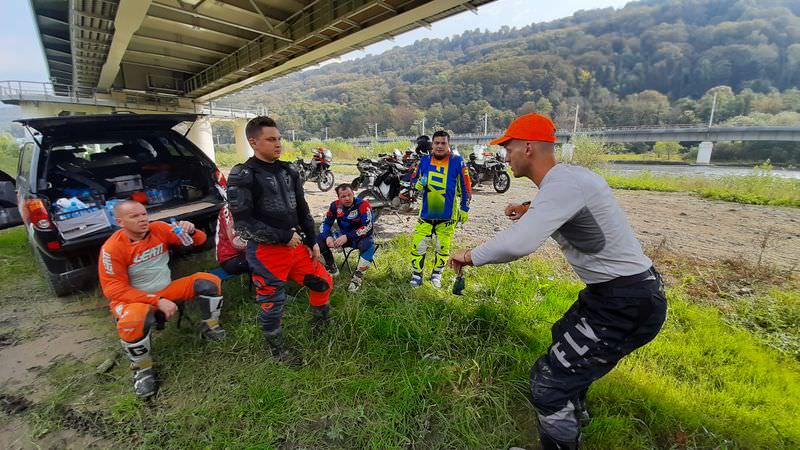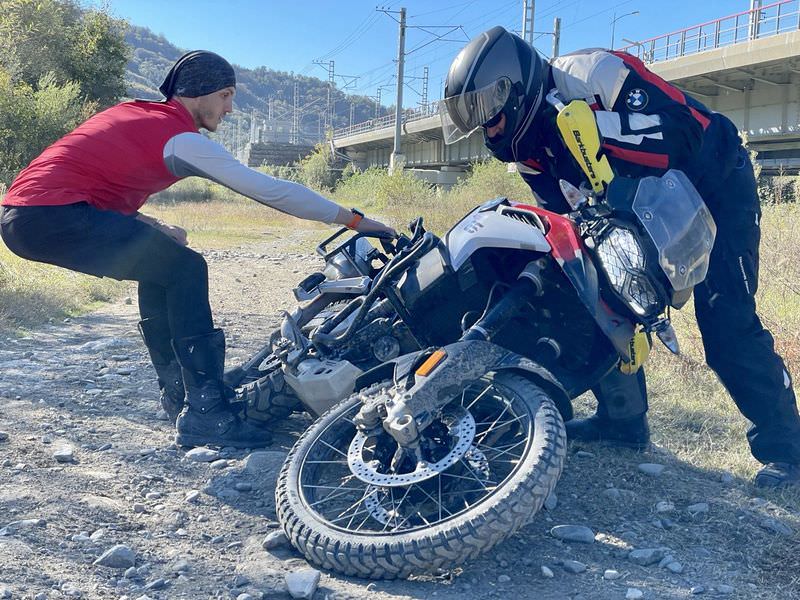
Alexander Grizo, RMT enduro training instructor, wrote a note on what to do if you suddenly went beyond the asphalt.
I will tell you a few basic rules of what to do if you find yourself outside the asphalt. You can stumble on gravel or unpaved road anywhere, even if you did not plan to go there. This could be a way to a beautiful place to take a picture, or roadworks, or change of route. And you must be prepared for all these events.
Of course, the ideal variant would be to get training in driving a motorcycle off road. Similar programs are offered by Schools all over the world, including here in Russia, for example, RMT or BMW
But unfortunately, lots of drivers appear in a difficult situation first, and only then realize, that they could learn before. However, here is an express course for survival on a motorcycle off road:
1. Stand up - the first thing to do is to stand on the motorcycle kickstands with your knees slightly bent, feel for the bottleneck of your motorcycle with them and fix it with light pressure on your knees. Feeling your feet holding onto the motorcycle, relax your arms, pull your elbows out to the sides, and lean forward slightly so that your head is above the handlebars
2. Do not grab the handlebars, your arms should be relaxed and bent (not straight). Your legs and arms should work in time with the suspension, absorbing bumps, do not turn into squeezed Pinocchio - this will do more harm than good. This position also gives you a better view
3. Look higher – do not look under the wheel, but at least 15-30 meters ahead, so you can plan your trajectory and go around sharp-edged pits or other obstacles in advance. Moreover, you will be able to notice a jigi-jeep running towards you earlier. And remember that you are always going where you are looking, so don't fix your eyes on obstacles, look past them, look where you want to gj
4. Two fingers - in the conditions of a constantly changing road under the wheels and shaking, you need to be ready for any maneuver at the same time, and so that the handlebars is not knocked out of your hands, so with the little finger and ring finger of both hands you should gently grab the grip (but not cling to it), and the middle and index fingers should rest on the brake and clutch levers, so that you can instantly use them if necessary, without wasting time changing your fingers from the grip to the lever.
5. Use your feet - the bike handles differently off-road than it does on pavement. When turning, the weight must be transferred to the OUTSIDE/footboard (opposite from asphalt riding). Therefore, when turning, for example, to the left, you must lean the motorcycle to the left, transfer your weight to the right footboard, move your pelvis, body, and head outward from the leaning motorcycle, resting your knee on the narrow part of the motorcycle that you felt earlier, and stay in this position until motorcycle straightening
6. Quick relief (sand, deep small gravel, etc.). If you did not recognize such a part of road in advance and suddenly fell into it, do not rush to stop, it will not be easy to start. Move as far back as possible, possibly even farther than the passenger seat, and use the slippage of the clutch to continue to apply power to the wheel, so you will pass the section "on the glider".
If you stay in the front position and hit the brakes, there's a good chance you'll dig in and fall.
7. If you are still going to fall, then you should feel when you approach the point of no return and understand that the fall is inevitable. At this point, try not to fight "to the victory", but to disconnect with the motorcycle in time and fall separately. This will help to avoid a situation where the motorcycle presses down your leg or something. A motorcycle is much easier and cheaper to fix than a human. Take care of yourself
8. Explore the possibilities of your motorcycle - modern motorcycles are full of electronics that can help you or, on the contrary, harm you off-road. Read the instructions, find out which assistants are installed on your motorcycle and learn how to turn them on and off in advance. In difficult conditions, you will have no time to deal with this
9. Motorcycle setup - if you understand that you will ride off-road long enough, then it makes sense to spend 10 minutes on small preparations
- Lower the windshield if possible
- Fold or take off the mirrors
- Remove the rubber pegs from the footboards to help you keep your feet on the ground and keep your feet from slipping.
- Lower the rear wheel to 2-2.2 atmospheres, this will give you a greater ride and better grip (do not lower the front, otherwise there is a chance to bend the disc on the stones)
- You can also switch the suspension to a softer mode and check if the panniers / bags are well fixed
These preparations will make a big difference in how you feel about the road, don't be lazy to spend 10-15 minutes on them
Good luck to everyone and see you at the RMT enduro school or on tours!



